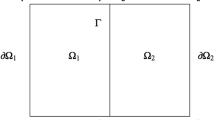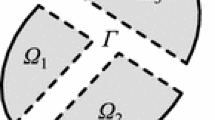Abstract
We consider the numerical simulation of the left ventricle of the human heart by a hyperelastic fiber reinforced transversely isotropic model. This is an important model problem for the understanding of the mechanical properties of the human heart but its calculation is very time consuming because the lack of fast, scalable method that is also robust with respect to the model parameters. In this paper, we propose and study a fully implicit overlapping domain decomposition method on unstructured meshes for the discretized system. The algorithm is constructed within the framework of Newton–Krylov methods with an analytically constructed Jacobian. We show numerically that the algorithm is highly parallel and robust with respect to the material parameters, the large deformation, the fiber reinforcement, and the geometry of the patient-specific left ventricle. Numerical experiments show that the algorithm scales well on a supercomputer with more than 8000 processor cores.










Similar content being viewed by others
References
Aris R (2012) Vectors, tensors and the basic equations of fluid mechanics. Courier Corporation, Chelmsford
Augustin CM, Neic A, Liebmann M, Prassl AJ, Niederer SA, Haase G, Plank G (2016) Anatomically accurate high resolution modeling of human whole heart electromechanics: a strongly scalable algebraic multigrid solver method for nonlinear deformation. J Comput Phys 305:622–646
Avazmohammadi R, Hill M, Simon M, Zhang W, Sacks M (2017) A novel constitutive model for passive right ventricular myocardium: evidence for myofiber-collagen fiber mechanical coupling. Biomech Model Mechanobiol 16(2):561–581
Balay S, Abhyankar S, Adams M, Brown J, Brune P, Buschelman K, Dalcin L, Dener A, Eijkhout V, Gropp W, Karpeyev D, Kaushik D, Knepley M, May D, McInnes L, Mills R, Munson T, Rupp K, Sanan P, Smith B, Zampini S, Zhang H, Zhang H (2020) PETSc Users Manual Revision 3.13, 2020
Bayer JD, Blake RC, Plank G, Trayanova NA (2012) A novel rule-based algorithm for assigning myocardial fiber orientation to computational heart models. Ann Biomed Eng 40(10):2243–2254
Bozdağ D, Catalyurek U, Gebremedhin AH, Manne F, Boman EG, Özgüner F (2005) A parallel distance-2 graph coloring algorithm for distributed memory computers. International conference on high performance computing and communications. Springer, New York, pp 796–806
Cai XC, Sarkis M (1999) A restricted additive Schwarz preconditioner for general sparse linear systems. SIAM J Sci Comput 21(2):792–797
Cai XC, Gropp WD, Keyes DE, Tidriri MD (1994) Newton–Krylov–Schwarz methods in CFD. Numerical methods for the Navier–Stokes equations. Springer, New York, pp 17–30
Chen R, Cai XC (2012) Parallel one-shot Lagrange–Newton–Krylov–Schwarz algorithms for shape optimization of steady incompressible flows. SIAM J Sci Comput 34(5):B584–B605
Chen W, Gao H, Luo X, Hill N (2016) Study of cardiovascular function using a coupled left ventricle and systemic circulation model. J Biomech 49(12):2445–2454
Ciarlet PG (1988) Mathematical elasticity, volume i: three-dimensional elasticity. North-Holland
Franzone PC, Pavarino LF, Scacchi S (2015) Parallel multilevel solvers for the cardiac electro-mechanical coupling. Appl Numer Math 95:140–153
Franzone PC, Pavarino LF, Scacchi S (2018) A numerical study of scalable cardiac electro-mechanical solvers on HPC architectures. Front Physiol 9:268
Gao H, Wang H, Berry C, Luo X, Griffith BE (2014) Quasi-static image-based immersed boundary-finite element model of left ventricle under diastolic loading. Int J Numer Meth Bio 30(11):1199–1222
Gebremedhin AH, Manne F, Pothen A (2005) What color is your Jacobian? Graph coloring for computing derivatives. SIAM Rev 47(4):629–705
Göktepe S, Kuhl E (2010) Electromechanics of the heart: a unified approach to the strongly coupled excitation-contraction problem. Comput Mech 45(2–3):227–243
Guan D, Ahmad F, Theobald P, Soe S, Luo X, Gao H (2019) On the AIC-based model reduction for the general Holzapfel–Ogden myocardial constitutive law. Biomech Model Mechanobiol 18(4):1213–32
Guccione JM, McCulloch AD, Waldman L (1991) Passive material properties of intact ventricular myocardium determined from a cylindrical model. ASME J Biomech Eng 113:42–55
Gurev V, Pathmanathan P, Fattebert JL, Wen HF, Magerlein J, Gray RA, Richards DF, Rice JJ (2015) A high-resolution computational model of the deforming human heart. Biomech Model Mechanobiol 14(4):829–849
Holzapfel GA, Ogden RW (2009) Constitutive modelling of passive myocardium: a structurally based framework for material characterization. Philos Trans R Soc A: Math Phys Eng Sci 367(1902):3445–3475
Hosoi A, Washio T, Okada JI, Kadooka Y, Nakajima K, Hisada T (2010) A multi-scale heart simulation on massively parallel computers. In: SC’10: Proceedings of the 2010 ACM/IEEE international conference for high performance computing, networking, storage and analysis. IEEE, pp 1–11
Kong F, Cai XC (2016) A highly scalable multilevel Schwarz method with boundary geometry preserving coarse spaces for 3D elasticity problems on domains with complex geometry. SIAM J Sci Comput 38(2):C73–C95
Land S, Niederer SA, Smith NP (2011) Efficient computational methods for strongly coupled cardiac electromechanics. IEEE Trans Biomed Eng 59(5):1219–1228
Land S, Gurev V, Arens S, Augustin CM, Baron L, Blake R, Bradley C, Castro S, Crozier A, Favino M et al (2015) Verification of cardiac mechanics software: benchmark problems and solutions for testing active and passive material behaviour. Proc R Soc A: Math Eng Sci 471(2184):20150641
Langdon S, Chernecky R, Pereira C, Abdulla D, Lee J (1999) Biaxial mechanical/structural effects of equibiaxial strain during crosslinking of bovine pericardial xenograft materials. Biomaterials 20(2):137–153
Merodio J, Ogden R (2006) The influence of the invariant I8 on the stress-deformation and ellipticity characteristics of doubly fiber-reinforced non-linearly elastic solids. Int J Non-Linear Mech 41(4):556–563
Möller T, Hughes JF (1999) Efficiently building a matrix to rotate one vector to another. J Graph Tools 4(4):1–4
Nash MP, Hunter PJ (2000) Computational mechanics of the heart. J Elast Phys Sci Solids 61(1–3):113–141
Nobile F, Quarteroni A, Ruiz-Baier R (2012) An active strain electromechanical model for cardiac tissue. Int J Numer Meth Biol 28(1):52–71
Okada J, Washio T, Hisada T (2010) Study of efficient homogenization algorithms for nonlinear problems. Comput Mech 46(2):247–258
Pavarino L, Scacchi S, Zampini S (2015) Newton–Krylov-BDDC solvers for nonlinear cardiac mechanics. Comput Method Appl Mech Eng 295:562–580
Pavarino L, Scacchi S, Verdi C, Zampieri E, Zampini S (2017) Scalable BDDC algorithms for cardiac electromechanical coupling. Domain decomposition methods in science and engineering XXIII. Springer, New York, pp 261–268
Pinto J, Fung Y (1973) Mechanical properties of the heart muscle in the passive state. J Biomech 6(6):597–616
Reumann M, Fitch BG, Rayshubskiy A, Keller DU, Seemann G, Dossel O, Pitman MC, Rice JJ (2009) Strong scaling and speedup to 16,384 processors in cardiac electro-mechanical simulations. In: 2009 annual international conference of the IEEE Engineering in Medicine and Biology Society, pp 2795–2798
Riviere B (2008) Discontinuous Galerkin methods for solving elliptic and parabolic equations: theory and implementation. SIAM, Philadelphia
Saad Y (2003) Iterative methods for sparse linear systems. SIAM, Philadelphia
Santiago A, Aguado-Sierra J, Zavala-Aké M, Doste-Beltran R, Gómez S, Arís R, Cajas JC, Casoni E, Vázquez M (2018) Fully coupled fluid-electro-mechanical model of the human heart for supercomputers. Int J Numer Meth Biol 34(12):e3140
Scollan DF, Holmes A, Winslow R, Forder J (1998) Histological validation of myocardial microstructure obtained from diffusion tensor magnetic resonance imaging. Am J Physiol-Heart C 275(6):H2308–H2318
Shen JJ (2016) A structurally based viscoelastic model for passive myocardium in finite deformation. Comput Mech 58(3):491–509
Toussaint N, Sermesant M, Stoeck CT, Kozerke S, Batchelor PG (2010) In vivo human 3D cardiac fibre architecture: reconstruction using curvilinear interpolation of diffusion tensor images. International conference on medical image computing and computer-assisted intervention. Springer, New York, pp 418–425
Wang H, Luo X, Gao H, Ogden R, Griffith B, Berry C, Wang T (2013) A modified Holzapfel–Ogden law for a residually stressed finite strain model of the human left ventricle in diastole. Biomech Model Mechanobiol. https://doi.org/10.1007/s10237-013-0488-x
Wong J, Kuhl E (2014) Generating fibre orientation maps in human heart models using Poisson interpolation. Comput Methods Biomech Biomed Eng 17(11):1217–1226
Zienkiewicz OC, Taylor RL (2005) The finite element method for solid and structural mechanics. Elsevier, Amsterdam
Acknowledgements
This work was partially supported by the National Key R&D Program of China 2016YFB0200601, Shenzhen grants under ZDSYS201703031711426 and JCYJ20180507182506416, and the Strategic Priority Research Program of Chinese Academy of Sciences, Grant No. XDC01040100.
Author information
Authors and Affiliations
Corresponding author
Ethics declarations
Conflict of interest
The authors declare that they have no conflict of interest.
Additional information
Publisher's Note
Springer Nature remains neutral with regard to jurisdictional claims in published maps and institutional affiliations.
Rights and permissions
About this article
Cite this article
Jiang, Y., Chen, R. & Cai, XC. A highly parallel implicit domain decomposition method for the simulation of the left ventricle on unstructured meshes. Comput Mech 66, 1461–1475 (2020). https://doi.org/10.1007/s00466-020-01912-3
Received:
Accepted:
Published:
Issue Date:
DOI: https://doi.org/10.1007/s00466-020-01912-3




